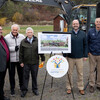After the American Civil War, some Adventists refocused their energy from the abolition of slavery to the Southern work, which, in part, meant ministering to the now-free Black population.
Although the church did not initially have a cohesive strategy for the Southern work, there were soon many Black Adventists.
The first ordained Black Adventist pastor was Charles Marshall Kinny, who had been born into slavery in 1855 and heard Ellen White and J.N. Loughborough speak in Reno, Nevada, in 1878. Kinny became an Adventist later that year and attended what is now Pacific Union College in the 1880s. In 1888, he moved to St. Louis, Missouri, preaching and ministering to the Black community.
There was one Adventist Church there at the time, and as Kinny was successful in evangelizing the Adventist message to the Black community, the demographics of the church began to change.
The Adventist Church in St. Louis, unsettled by the changing demographics of the congregation, reacted negatively toward Black people who tried to attend. Kinny left to continue his ministry in Kentucky, but carried with him the sting of the racism he had experienced.
Ellen White herself visited the church after Kinny left and was so disturbed by the racism she witnessed there that she was compelled to write to the General Conference leadership, “Our Duty to the Colored People,” which sternly called on churches and leaders to treat Black attendees with dignity and respect.
Similar tensions were growing across America, with white congregants separating themselves to form churches apart from their Black fellow Adventists.
In the aftermath of a failed reconstruction, the Adventist Church struggled as it filled not only with recently freed Black congregants and abolitionists, but also with white people from both the North and South who were entrenched in racist cultural norms.
Integrated Adventist churches became increasingly rare, and they also became more dangerous. Churches were threatened by angry mobs, and Black congregants could not worship without facing risks to their safety or experiencing prejudice from within the pews.
Adventist missionaries in the South faced increased danger to the point where some decided to return to the North for their own safety. Others began to be swayed by Southern rhetoric and racism themselves.
This is why, just four years after Ellen White admonished GC leaders that Black Adventists should not be excluded from places of worship, she wrote this: “In regard to white and colored people worshiping in the same building, this cannot be followed as a general custom with profit to either party — especially in the South. The best thing will be to provide the colored people who accept the truth with places of worship of their own, in which they can carry on their services by themselves. Let them understand that this plan is to be followed until the Lord shows us a better way.”
Unfortunately, as Calvin B. Rock, Ph.D., stated, the meaning of “a better way” changed from “when we figure out a safer approach” to “when Jesus returns.” The church quickly shifted from taking an active role in dismantling systems of oppression to distancing itself from issues of justice and worse, perpetuating the injustice of the world in its own spaces.
Michael Campbell, an Adventist historian, wrote during his time as professor of religion at Southwestern Adventist University, “Adventism goes from being a church that's abolitionist and very activist ... many of our pioneers were participants on the underground railroad. But we get to the point in the early 20th century, by the early 1940s, where we have to have separate Black and white conferences. We have Black and white sections of the cafeteria at the GC, most of our schools became Black and white.”
So how did this happen? If Adventism was originally so closely tied with the abolitionist movement, how did it become one of the very last Christian denominations to desegregate in the 1960s?
As the Adventist Church became more institutional and drifted closer to its fundamentalist Christian neighbors in the early and mid-20th century — who had not only not been abolitionists but had upheld slavery as a God-given institution — it became slower and slower to act in support of the pleas for equity from its Black membership.
Years of requests for a specific department in the GC that would provide support and resources for Black Adventist ministers finally resulted in the “Negro Department,” which itself took another nine years before it got its first Black director.
Before that, the department was led by a succession of three white men. The department’s first Black director, W.H. Green, died of exhaustion after only 10 years due to his intense travel schedule and being one of the only official leaders for Black Adventism’s growing congregations.
After the death of Ellen White, amid the rise of the Ku Klux Klan and the deadly Red Summer of 1919, the Adventist Church failed to adequately address the issues of their day. Instead of continuing its radical, activist roots in the area of racial equity, it fell in line with America’s discriminatory laws.
When Lucy Byard, a Black Adventist seeking life-saving medical attention from an Adventist Sanitarium in Maryland, was turned away based on her race and ultimately died because of it in 1943, the dam finally broke.
With all other avenues already exhausted, a powerful protest movement broke out and North American Division was finally pushed into the creation of Black-administered conferences, known today as regional conferences.
Finally empowered to lead and minister from their own experiences, gifts and perspectives, the church blossomed in new areas thanks to the administration of its Black leadership. Though they began as a support system for Black Adventist ministry, regional conferences today lead a diverse array of Adventists, churches and ministries, and they function as the architects of indigenous leadership models globally.
Many Adventists in the Pacific Northwest may be aware of the fact that in our territory we do not have separate “regional” and “state” conferences. Regional ministry, however, continues to be a powerful force for ministry in our region.
As Byron Dulan, North Pacific Union vice president for regional affairs, shared in his recent article, “Black Roots Run Deep,” “Black Northwest Adventists trace their spiritual roots back more than 100 years. Adventist gospel ministry first began among African Americans on the Pacific Coast around 1907.”
With racism still thriving in the U.S. and, in many cases, in our church today, regional ministries remain vital trailblazers in a wide spectrum of communities.
As recently as the late 1990s, Black Adventist leaders in Southeastern California pushed for the creation of new regional conferences in their area, revealing yet again that the needs of a large group of Adventists were not being heard, understood or adequately met.
Still today, in 2024, there is a desperate need for church administration and the greater Adventist community to listen when a group voices concerns that they are not being supported or heard by their church.
If we are to avoid perpetuating the sins of our past, our challenge today is to rediscover Adventism’s radical roots in social equity and to support those living leaders who have taken up the standard of their foremothers and forefathers in ministry.
_________________________
This article was adapted from episodes 5 and 6 of How the Church Works, a podcast written and produced by Heather Moor, Nina Vallado and Kaleb Eisele and sponsored by the Adventist Learning Community. To listen to both episodes on Adventist regional conferences or learn more about the podcast, visit howthechurchworks.com. Written adaptation by Kaleb Eisele in partnership with North Pacific Union of Seventh-day Adventists.









